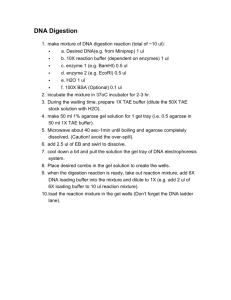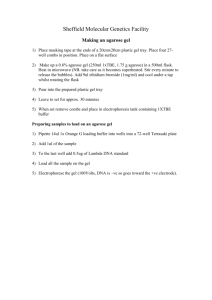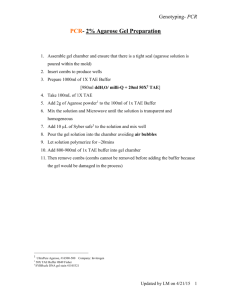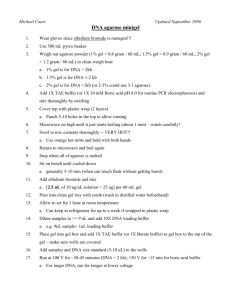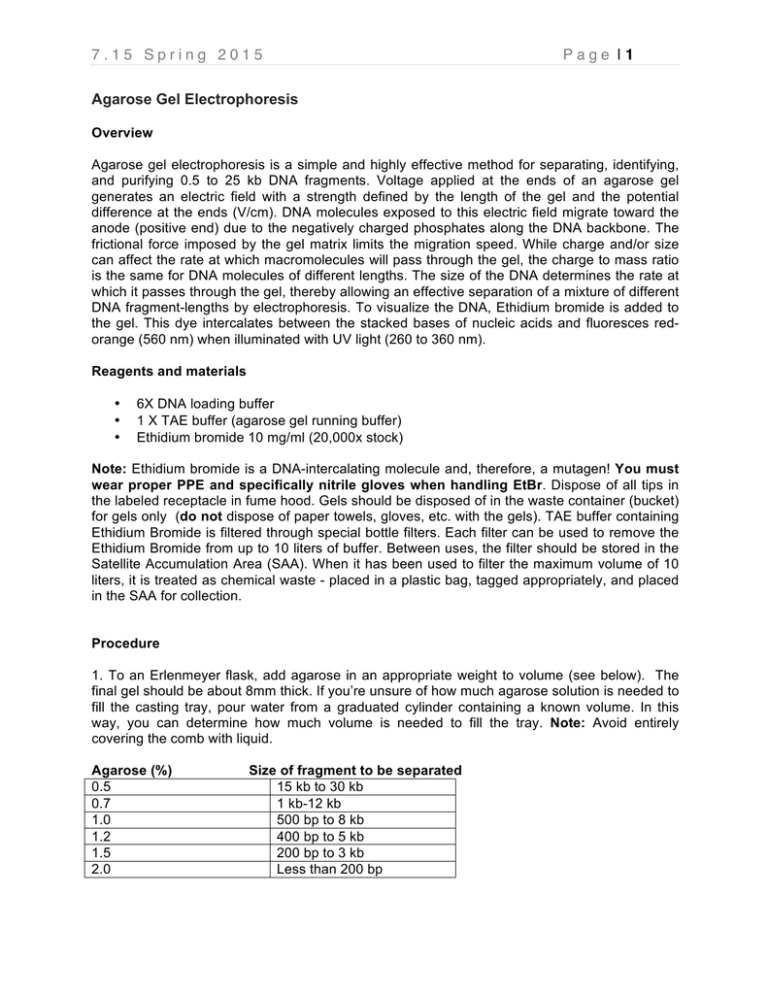
7.15 Spring 2015
Page |1
Agarose Gel Electrophoresis
Overview
Agarose gel electrophoresis is a simple and highly effective method for separating, identifying,
and purifying 0.5 to 25 kb DNA fragments. Voltage applied at the ends of an agarose gel
generates an electric field with a strength defined by the length of the gel and the potential
difference at the ends (V/cm). DNA molecules exposed to this electric field migrate toward the
anode (positive end) due to the negatively charged phosphates along the DNA backbone. The
frictional force imposed by the gel matrix limits the migration speed. While charge and/or size
can affect the rate at which macromolecules will pass through the gel, the charge to mass ratio
is the same for DNA molecules of different lengths. The size of the DNA determines the rate at
which it passes through the gel, thereby allowing an effective separation of a mixture of different
DNA fragment-lengths by electrophoresis. To visualize the DNA, Ethidium bromide is added to
the gel. This dye intercalates between the stacked bases of nucleic acids and fluoresces redorange (560 nm) when illuminated with UV light (260 to 360 nm).
Reagents and materials
•
•
•
6X DNA loading buffer
1 X TAE buffer (agarose gel running buffer)
Ethidium bromide 10 mg/ml (20,000x stock)
Note: Ethidium bromide is a DNA-intercalating molecule and, therefore, a mutagen! You must
wear proper PPE and specifically nitrile gloves when handling EtBr. Dispose of all tips in
the labeled receptacle in fume hood. Gels should be disposed of in the waste container (bucket)
for gels only (do not dispose of paper towels, gloves, etc. with the gels). TAE buffer containing
Ethidium Bromide is filtered through special bottle filters. Each filter can be used to remove the
Ethidium Bromide from up to 10 liters of buffer. Between uses, the filter should be stored in the
Satellite Accumulation Area (SAA). When it has been used to filter the maximum volume of 10
liters, it is treated as chemical waste - placed in a plastic bag, tagged appropriately, and placed
in the SAA for collection.
Procedure
1. To an Erlenmeyer flask, add agarose in an appropriate weight to volume (see below). The
final gel should be about 8mm thick. If you’re unsure of how much agarose solution is needed to
fill the casting tray, pour water from a graduated cylinder containing a known volume. In this
way, you can determine how much volume is needed to fill the tray. Note: Avoid entirely
covering the comb with liquid.
Agarose (%)
0.5
0.7
1.0
1.2
1.5
2.0
Size of fragment to be separated
15 kb to 30 kb
1 kb-12 kb
500 bp to 8 kb
400 bp to 5 kb
200 bp to 3 kb
Less than 200 bp
7.15 Spring 2015
Page |2
2. Add appropriate amount of 1X TAE to the flask. **Do not make your agarose in water!**
Bring slurry to a boil in a microwave (heat about 2 minutes on high power), swirl carefully, and
repeat as necessary until no "streaks" or chunks remain.
** Be careful with molten agar and agarose. It can boil over suddenly and cause burns.
Use an orange autoclave mitten or the rubber bottle mittens.
3. Once agarose is completely dissolved, add Ethidium bromide in the hood, to a final
concentration of 0.5 µg/ml (WEAR GLOVES!) – for example 5 µl in 100 ml of agarose solution.
Swirl to mix.
4. Set up the gel tray in the gel box (in the casting orientation, which is perpendicular to the long
axis of the gel box) and insert a comb. Pour molten agar into the gel box in the hood. Any air
bubbles in the solution can be removed with a pipet tip.
5. The agar is completely set when it becomes opaque (< 20 min). If you prepare your gel
ahead of time, wrap it in plastic wrap and store it at 4°C.
6. Add the loading buffer/dye to your DNA samples to a final concentration of 1X. DNA loading
buffer is 6X.
7. Set up your gel box for the run. The casting tray has to be placed so that the open ends of the
tray are continuous with the buffer reservoirs at either end of the gel box. Add 1X TAE buffer
(same as the buffer used to make the agarose gel) to the box. The gel should be covered by
buffer (about 5-8 mm deep above the gel); this allows current to pass from one electrode to the
other, through the gel.
8. Before loading samples on the gel, make sure that the wells contain buffer. You can gently
flush out any air bubbles that may be in the well with the 1X TAE buffer. Load samples on the
gel. Remember to also load a molecular weight marker of the appropriate sizes. See the end of
this protocol for the patterns of commonly used 1 kb and 100 bp molecular weight markers
available in lab.
9. Run the gel at 80-120V. If time permits, run the gel at a voltage that is at the lower end of the
range. Runs at high voltage disrupt resolution and the DNA bands will appear fuzzy. Note: The
bromophenol blue (dark blue) in the loading dye will migrate with an apparent molecular weight
of 300-500 bp and the xylene cyanol (light blue) at 2-4 kb.
10. When the gel has run far enough (the bromophenol blue should still be in the gel, especially
if you are interested in bands that are less than 300 bp), view the gel using the imager and the
UV box in the dark room. If the bands have clearly separated and you can determine the sizes,
the run can be stopped and you can take a picture of the gel.
Note on electrophoresis of RNA samples:
You may wish to check the integrity of RNA samples by running a very small volume on an
agarose gel. In this case, use the smallest gel tray and comb that forms the smallest wells
available. Since the reagents (agarose, TAE, etc.) are unlikely to be free of RNases (that
degrade RNA), the gel has to be loaded quickly and run only for the amount of time needed to
resolve the two prevalent rRNA types found in total RNA preparations. Alternatively, TAE buffer
can be made using DEPC (RNAse-free) water.
7.15 Spring 2015
Page |3
Solutions
6X DNA loading buffer
2.5% Ficoll
11 mM EDTA
3.3 mM Tris-HCl
0.017% SDS
0.015% bromophenol blue
0.015% xylene cyanol
pH 8.0@25°C
Make a volume in a 50 ml Falcon tube, dispense into aliquots, and store at RT.
1X TAE (working solution)
40 mM Tris-acetate
2 mM Na2EDTA⋅2H2O
The stock buffer purchased for lab is 25X; to make 10 liters of 1X, mix 0.4 liter of 25X stock with
9.6 liters dH2O.
50X TAE stock
242 g Tris base
52.1 ml glacial acetic acid
37.2 g Na2EDTA⋅2H2O (Ethylene Dinitrile Tetraacetic disodium salt)
add dH2O for a final volume of 1 liter
7.15 Spring 2015
Page |4
DNA ladders (New England Biolabs)
1 kb ladder
100 bp ladder
© New England Biolabs. 100 bp DNA Ladder. All rights
© New England Biolabs. 1kb DNA Ladder. All rights
reserved. This content is excluded from our Creative
Commons license. For more information, see
http://ocw.mit.edu/help/faq-fair-use/.
reserved. This content is excluded from our Creative
Commons license. For more information, see
http://ocw.mit.edu/help/faq-fair-use/.
MIT OpenCourseWare
http://ocw.mit.edu
7.15 Experimental Molecular Genetics
Spring 2015
For information about citing these materials or our Terms of Use, visit: http://ocw.mit.edu/terms.



